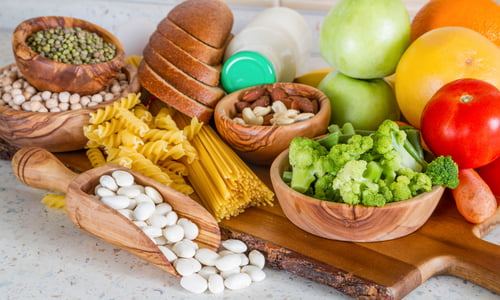Food Delivery for Elderly
“Food Delivery for Elderly” was written by Erin Washbon, RDN & edited/reviewed by Aly Bouzek, MS, RDN.
Caring for elderly, whether they live with you or not, is no easy task! There are many resources available to make food delivery more accessible.
Here, we’ll discuss how to get food to older adults and whether it’s through a federal nutrition assistance program or a company devoted to making meal times more convenient.
How Do You Get Food for Elderly?
Feeding our older generations is a challenge no matter what. Many families these days are sandwiched between the needs of growing children and aging adults. There is little time to devote to either and plenty of costs associated with both.
There are also many federal nutrition assistance programs, state nutrition assistance programs, and private organizations which (in combination) can provide some relief to families looking for answers.
This hefty blog post is intended to provide some clarification on options available to save you money, time, and stress. Let’s dive in!
How Much Does it Cost to Feed an Older Adult?
According to the Older Americans Act Nutrition Program Evaluation from 2015 the average cost of a congregate meal is $9.30 and the average cost of a home-delivered meal is $9.00.
This statistic is seven years old and food cost has changed dramatically since the pandemic. It may cost more than what is stated above to cover the food for the elderly.
This report is a great resource to understand how senior living facilities and the federal government work together under the US Department of Human and Health Services (DHHS) in order to properly feed our aging population.
How Many Elderly are Food Insecure?
According to the National Council on Aging, 5.2 million seniors in the US were food insecure in 2019. These numbers are sure to have increased since the beginning of the COVID-19 pandemic. (1)
There are many factors that influence the loss of access to food, or food insecurity, for older adults.
The loss of income in older years combined with the increasing costs of food contribute to food insecurity. Living on a low or fixed income makes affording even the most basic necessities difficult.
A lack of affordable housing is a related issue now more than ever with the ongoing housing crisis in the US. Even when older adults have access to income and aren’t worried about leaving the home, many lack adequate transportation and assistance with grocery shopping.
During the pandemic, elderly were at high risk and many might have been afraid to leave their home. Social isolation contributes to food insecurity when older adults don’t have the support needed to care for themselves.
High healthcare costs also contribute to the issue because older adults often have many healthcare-related expenses – limiting what they can spend on food.
Health Consequences of Food Insecurity for Elderly
Malnutrition occurs when the body does not get enough nutrients. In the United States, this doesn’t necessarily mean that people who are malnourished are thin.
Too much of any nutrients can also cause malnutrition and people can become malnourished even when they are considered obese. This is because a lot of accessible foods are high in energy and low in vitamins and minerals.
The more affordable processed foods contribute to the poor health outcomes of those suffering from food insecurity.
Important Nutrients for Older Adults to Watch:
- Vitamin B12 is a common deficiency in the elderly population. Vitamin B12 helps to keep blood and nerve cells healthy. A deficiency in this can cause numbness in fingers and toes which puts seniors at a higher risk for falling. (2)
- Vitamin D is important for bone health, the immune system, and muscle function. A deficiency in Vitamin D can be caused by decreasing kidney function or the lack of sunlight.
- Protein malnutrition is very common in senior populations. After age 30, adults lose 3-8% of their lean muscle mass every 10 years if inactive. (3)
Consuming enough protein and maintaining a healthy exercise schedule is vital to both quality of life and better health outcomes for the elderly.
- Omega-3 fatty acids are important in reducing cardiovascular risk, reducing cognitive decline, and increasing bone health in older populations. (4)
- Fiber is important for maintaining a healthy digestive system. Many older adults suffer from chronic constipation and/or diarrhea.
- Insoluble fiber helps to bulk up the feces in the digestive tract and soluble fiber helps things to move along much easier. Fiber also feeds the intestinal microbiome which can impact immune function, age-related chronic inflammation, and even cognitive function.
- Water is often overlooked in the elderly due to a decline in the thirst mechanism. They don’t feel thirsty until they are significantly dehydrated. Hydration status can affect every system in the body.

Does Medicare or Medicaid Cover Food Delivery for Elderly?
The Centers for Medicare & Medicaid Services (CMS) updated its rules for Medicaid Advantage programs to extend services.
This means that it can provide coverage for home-delivered meals or meal preparation services as an “optional supplemental benefit” to Medicaid Advantage programs.
Medicaid sometimes covers up to five days of food and the meals can be frozen, hot, or refrigerated. As Medicaid is a state run program, the resources vary by location.
What Are Senior Food Security Programs Options?
There are many programs available to seniors that can help with nutrition and food delivery for elderly. The federal government has programs set up to support various populations with food insecurity. (5)
Checking each of the following programs for eligibility is incredibly time consuming. The National Council on Aging has prepared the BenefitsCheckUp site for you to quickly check eligibility status for everything from food assistance to medications and tax relief.
8 Nutrition Assistance Programs for Seniors:
- Feeding America: Along with government programs for nutrition assistance, check out local organizations such as nonprofits, food banks, and food pantries! Feeding America has a wonderful online tool to locate local food banks and pantries!
- Supplemental Nutrition Assistance Program (SNAP): a federally funded program available to millions of elderly. It provides benefits which can be used in grocery stores, convenience shops, and farmers’ markets.
- The Senior Farmers’ Market Nutrition Program (SFMNP) is another federally funded option meant to provide low-income elderly with access to fresh fruits and vegetables, honey, and locally-grown herbs.
- The Food Distribution Program on Indian Reservations (FDPIR): provides USDA foods to seniors living on Indian Reservations.
- The Commodity Supplemental Food Program (CSFP): works to provide monthly food care packages made up of USDA commodity foods.
- The Program of All-Inclusive Care for the Elderly (PACE): is funded by Medicare and Medicaid. Seniors are often eligible for both PACE and Medicare/Medicaid benefits.
PACE provides services such as meal delivery, food prepared in your home by a care assistant, and/or meals by a partnering organization such as Meals on Wheels.
- Meals on Wheels is probably the most well known program that helps provide food for elderly. This program provides free or reduced cost meals delivered to the home.
The delivery is just as important as the food, often acting as a wellness check for many families who cannot afford to stay home with their older relatives. Check out our article on Meals on Wheels for Seniors to learn more.
- The Administration for Community Living: is an organization which funds meal delivery services. This addition is thanks to the Older Americans Nutrition Programs.

Can Elderly Get Food Stamps While on Social Security?
If an older adult lives in an assisted living or institutionalized setting which provides most of their meals, then they may be ineligible for SNAP. It’s worth checking out the rules and regulations, because there are exceptions to this.
Residents of federally assisted housing for elderly may be eligible for SNAP benefits, regardless of where they receive the most of their meals. (6)
Is There an Alternative to Meals on Wheels?
If you are ineligible for food assistance and programs like Meals on Wheels, there are many other options available for food delivery for elderly.
In partnership with the Administration of Community Living and the Administration on Aging, this site can help to locate food delivery for elderly programs in your area!
What Food Delivery for Elderly Services are the Best*?
*Disclaimer: This is not a paid advertisement. These food delivery services were found with an online search.
Best FOOD Delivery for Elderly
- Instacart is a resource that can be used by anyone, but it can be especially helpful for food delivery for elderly. It’s a same-day grocery delivery service that lets you shop from your favorite grocery stores.
- Walmart+ InHome allows you to shop for groceries online and then set preferences for how you would like the food delivered to your home. Options include: placed on your doorstep, brought into your garage, or put away in your kitchen.
- Amazon Fresh is only for Amazon Prime members, but it’s still a great option as many families share one Amazon Prime subscription. You can discuss grocery needs with your loved one and then have the food delivered directly to their home.
- Thrive Market is a great food delivery for elderly option if you have a special diet or are wanting to have organic foods delivered.
- Boxed delivers bulk groceries as well other wholesale products like health supplies and household products.
- Imperfect Foods is a great choice for seasonal produce. These “imperfect foods” are still delicious and safe to eat! This is a sustainable food delivery option that helps fight food waste while being conveniently delivered to your home.
Make sure to visit Best Grocery Delivery Plans for Seniors to learn more about food delivery options for elderly and which option would be best for you or your loved one!

Best MEAL Delivery for Elderly
- Homestyle Direct is a Medicaid partnering organization that provides delicious, dietitian-approved, meals for seniors on a limited budget using the Medicaid Waiver.
The waiver is a state-federal partnership that provides services to seniors and people with disabilities so that they may stay in their own home, rather than going to a facility.
Without the Medicaid Waiver, 12 meals will ship to your home for a flat fee of $21.95. The ready to eat meals are flash frozen, shipped, and ready for reheating.
- Mom’s Meals provides options made by professional chefs and registered dietitians. The recipes are designed to accommodate health conditions and recovery after a hospital stay.
- Magic Kitchen offers a wide variety of subscription programs. There are at least 11 separate menus for specific dietary needs such as diabetic or dialysis-friendly, and a senior coupon code for large orders.
- Silver Cuisine partners with AARP and offers discounts to its members. There are no contracts or minimums on orders. The cost is a little higher, but the menu is marketed as an upscale option for food delivery for elderly.

Additional helpful meal resources:
If you want to learn more about the efficacy of the Older Americans Nutrition Act programs, check out this resource from the US Department of Health and Human Services Administration for Community Living.
Resources:
- Senior Food Insecurity Studies. Feeding America. https://www.feedingamerica.org/research/senior-hunger-research/senior.
- O’Leary F and Samman S. Vitamin B12 in Health and Disease. Nutrients. 2010;2(3):299-316. https://www.ncbi.nlm.nih.gov/pmc/articles/PMC3257642/.
- Volpi E, Nazemi R, and Fujita S. Muscle tissue changes with aging. Current Opinion in Clinical Nutrition & Metabolic Care. 2004;7(4):405-410. https://www.ncbi.nlm.nih.gov/pmc/articles/PMC2804956/.
- Ubeda N, Achon M, & Varela-Moreiras G. Omega 3 fatty acids in the elderly. British Journal of Nutrition. 2012:107(S2):137-151. https://www.cambridge.org/core/journals/british-journal-of-nutrition/article/omega-3-fatty-acids-in-the-elderly/7F39F0A262107FC3CDCA6BEAC6148E30.
- Assistance for Seniors Age 60 and Over. USDA Food and Nutrition Service. https://www.fns.usda.gov/program/assistance-seniors.
- SNAP Special Rules for the Elderly or Disabled. USDA Food and Nutrition Service. https://www.fns.usda.gov/snap/eligibility/elderly-disabled-special-rules.
